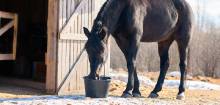
Winter diet check: how to fine-tune your horse’s nutrition
Whether you want to help a lean horse gain condition, maintain energy without extra bulk, or support an older horse struggling to keep weight on, our practical winter-feeding advice offers something for every equine.
Winter changes how your horse uses energy. Limited turn-out and lower-quality grazing mean they rely more on hay, haylage, and concentrates, and they burn extra calories just to stay warm.
For horses prone to putting on extra pounds, winter provides an opportunity to manage their weight before spring. For lean or older equines, winter can be a struggle to maintain condition. By tailoring your horse’s diet now, you can balance energy, body condition and temperament before the coldest months hit.
Early winter is a good time to prepare horses for harsher weather ahead. Adjusting feeding routines – including the type of forage and hard feed – gives you greater control over condition and reduces the risk of winter weight loss or gain spiralling out of control.
Feeding strategies for every horse
Not every horse requires the same amount of feed. Some need extra calories to gain or maintain condition; others need steady energy without weight gain, and many just need stamina without becoming excitable.
Overweight horses
Winter is the easiest time to slim down an overweight horse. Switch to low-calorie hay or haylage and carefully weigh forage – around 1.5% of bodyweight per day is usually sufficient.
Small-holed haynets, hay ball feeders, or spreading feed across multiple locations all encourage slower eating and gentle movement. Targeted horse feed for weight loss, such as low-calorie balancers along with chaff, can provide essential nutrients without adding extra calories – perfect for those needing to shed a little weight.
Lean or older horses
The best feed for weight gain in horses is typically fibre- and oil-based – rather than starch-heavy – delivering digestible calories without upsetting the gut.
High-fibre feeds and forage, such as haylage and soaked beet, provide slow-release energy, while added oils boost energy without increasing feed volume. This strategy helps prevent digestive issues and conditions such as laminitis, which can be triggered by high-starch diets. If muscle development is a goal, consider adding feeds high in protein, such as alfalfa.
The best weight-gain feed for old horses is soft, nutrient-dense and easy to chew, helping maintain condition when teeth or digestion are compromised. For example, a veteran horse struggling with weight might benefit from readily digestible options such as a short-chop fibre feed, paired with a conditioning balancer and a daily oil supplement to support overall body condition.
Good doers needing energy
Horse feed that provides energy, without weight gain, is useful for horses at a healthy weight that need stamina. Again, fibre-based concentrates with added oil provide slow-release energy, helping horses work without becoming overfed or fizzy. Adding a small quantity of oats or competition mix to feed can be a useful rapid-release energy source, too.
Use oils wisely
Adding oil is one of the simplest ways to increase calories without increasing meal volume. The best oil to feed horses for weight gain depends on your horse’s needs:
- Linseed oil: Rich in omega-3 fatty acids, great for coat and overall condition.
- Soya oil: Very calorie dense. Promotes coat shine and weight gain, though lower in beneficial fatty acids.
- Rapeseed oil: A balanced source of omega-3 and 6. It maintains and improves body condition and is a good source of non-heating energy.
In practice, oils should be introduced gradually, starting with one to two tablespoons per meal and adjusting as needed. Mixed into soaked fibre or cubes, they improve caloric intake and support slow-release energy.
Monitor condition and behaviour
Even the best feeding plan needs careful monitoring. Weigh all forage and concentrates, as guessing can lead to over- or under-feeding. Body condition scoring (BCS) once a month helps track topline, fat coverage and overall progress, while weekly photos can reveal subtle changes.
Feeding also affects temperament. High-starch feeds can make horses fizzy, while fibre and oil provide calmer, sustained energy. Finding the right balance ensures your horse stays healthy, happy and motivated without behavioural issues.
Practical tips for poor doers
Fussy eaters, anxious horses, veterans and breeds such as Thoroughbreds are prone to weight loss, so often need small, frequent meals. This may entail three to four feeds daily, combined with ad-lib forage to help maintain weight safely.
Pair feeding strategies with proper rugging and turnout shelter or stabling to minimise winter stress and support condition. Mouth pain can cause horses and ponies to stop eating, so regular dental visits are key to preventing issues from developing.
If your horse is struggling to keep condition, or if your usually good-doer starts losing too much weight, there may be an underlying cause. Always consult your vet if you’re concerned.
As with all aspects of horse health, unexpected veterinary needs can arise, which is why having reliable horse insurance in place offers extra peace of mind.
5 golden rules for winter feeding
- Match feed to your horse, not the season. What works for an older Thoroughbred won’t suit a native type.
- Fibre first. Forage should form the bulk of the diet; concentrates and oil are supplements, not substitutes.
- Monitor, measure, adjust. Weigh feed, score condition monthly and tweak diets as needed.
- Multiple small meals are better than one large feed. This is especially true of poor doers or older horses with digestive sensitivities.
- Keep an eye on hydration. Hay, cubes and mashes should be well-soaked when needed to support gut health in winter and to avoid the risk of impaction colic.
Found this article useful? Want to see more similar content and engage with like minded horse owners, Follow us on Petplan Equine's Facebook page.



